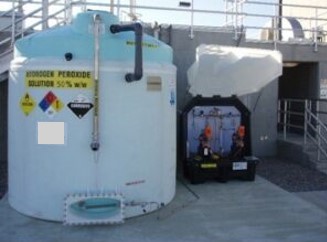Hydrogen Peroxide
Hydrogen peroxide (H2O2) is a powerful oxidant that oxidizes hydrogen sulfide (H2S), with byproducts of sulfur, water and oxygen. Hydrogen peroxide is commonly injected into a wastewater stream (force main, gravity sewer) to control H2S and other odorous compounds associated with wastewater collection and treatment. It may also supplement dissolved oxygen levels in the wastewater to prevent additional formation of hydrogen sulfide.
Typical Hydrogen Peroxide Storage Tank and Feed Equipment
The injection point is critical and should be fed 10 – 20 minutes upstream of the control point. Hydrogen peroxide is considered a hazardous chemical and therefore requires secondary containment, special operator training, handling and security precautions.
Hydrogen peroxide has been historically effective in oxidizing hydrogen sulfide for odor control in wastewater treatment systems.
Advantages may include:
- low capital costs
- quick and easy installation
- fast reaction time
- may increase dissolved oxygen level of wastewater
- produces no harmful by-products
Disadvantages may include:
- Operating costs may be high because chemical has to be purchased
- Hazardous chemical
- Secondary containment required
- Special operator training
- Safety and security precautions required
Providers have introduced a chemical treatment technology that combines iron salts with hydrogen peroxide for hydrogen sulfide control. The technology is called “Peroxide Regenerated Iron – Sulfide Control” (PRI-SC). Iron salts are used as the primary sulfide control chemical and the hydrogen peroxide is used to regenerate the iron from the spent iron salts. Typically, the iron salts are added at the lift station and the hydrogen peroxide is added at intermediate points downstream in the force main, particularly close to the discharge location. The hydrogen peroxide is added to regenerate the iron salts and to oxidize residual hydrogen sulfide. U.S. Peroxide claims an advantage to this technology is the chemical dosages and resulting chemical costs may be reduced over either iron salts or hydrogen peroxide alone.
Applicable Treatment Processes
- Force mains and gravity sewers.
- Upstream of WWTP headworks facilities
- Application to lagoon surfaces
Major Design Considerations
Precautions
Secondary containment, safety and security precautions should be included in the design of the injection system.
Location of injection system
Must be located 10-20 minutes upstream of the control point to be optimally effective.

